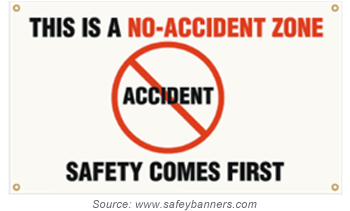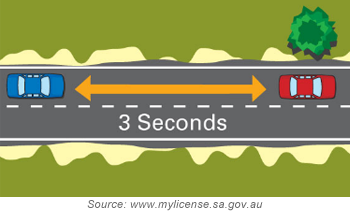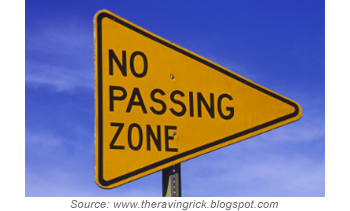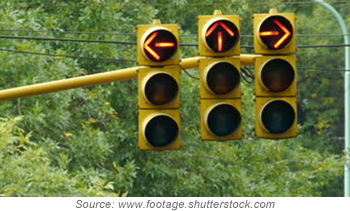7.2 Common Causes of Collisions
Collisions are NOT accidents. An “accident” implies an unforeseen event that occurs without anyone’s fault or negligence. Most often this is not the case when driving and most crashes can be avoided.

7.2.1 Unsafe Speed
Speeding is a multi-tiered threat because not only does it reduce the amount of time necessary to avoid a crash, but it also increases the risk of crashing and makes the crash more severe if it does occur.
According to the Insurance Institute for Highway Safety (IIHS), when speed increases from 40 mph to 60 mph, the energy released in a crash more than doubles.
Simply slowing down and obeying posted speed limits can go a long way toward making the roads safer. The U.S. Highway Patrol reported that an average of 112,000 people will receive a speeding ticket in one day, with 41,000,000 on average speeding tickets being issued in one year. Additionally, speeding is one of the major causes of traffic collisions, particularly for younger or newer drivers. The Department of Motor Vehicles reports that speeding was the leading factor in 35.3% of fatal crashes caused by drivers between the ages of 16 to 19. Furthermore, speeding is a factor in more than half of fatal crashes caused by teen drivers, according to National Highway Traffic Safety Administration.

Collisions are more likely to happen when one driver goes faster or slower than the other cars on the road. If you drive faster than other traffic, you increase your chances of being involved in a collision. Studies have shown that speeding does not save more than a few minutes in an hour of driving time. It is better to slow down and be safe, than to save a few minutes by speeding and possibly endanger yourself or others.
The faster you drive, the greater distance will be needed to safely stop your vehicle. A car traveling at 55 miles per hour will take approximately 400 feet to react and bring your vehicle to a stop. At 35 mph it takes about 210 feet to react and come to a complete stop.
Driving slower than other vehicles or stopping suddenly can be just as dangerous as speeding. In some instances, it can more dangerous because you may cause other drivers to swerve to avoid hitting your vehicle, or even worse, cause a rear-end collision. If you are in the fast lane and you notice vehicles moving to the right lane to pass you, or a line of vehicles is forming behind you, be considerate and move into the right lane, when it is safe, and let the vehicles pass.
7.2.2 Stopping Distance
There are three things that add up to total stopping distance:

Perception Distance
This is the distance your vehicle moves from the time your eyes see a hazard, until your brain comprehends it. In other words, the distance traveled from the time your brain tells your foot to move from the accelerator, until your foot is actually pushing the brake pedal. The perception time for an alert driver is about 3/4 second.
Braking Distance
The distance it takes to stop once the brakes are put on is the braking distance. At 55 mph on dry pavement with good brakes, it can take a vehicle about 145 feet to stop. If your vehicles brakes are worn or the pavement is slippery due to rain, snow, or sand, then the distances will substantially increase.
When deciding what speed you should be traveling at, you should consider the overall road conditions. Never travel too fast or too slow for the roads conditions. When you are driving down a street or roadway monitored by traffic control devices, or anywhere that stopping might occur, you should always allow a safe space cushion between yourself and the cars in front of you.

7.2.3 Driving on the Wrong Side of the Road
Driving on the wrong side of the road is a leading cause of traffic collisions. It may be tempting to pass stopped traffic when there is a line of vehicles, but it is never safe to do so. If you are following a vehicle that is traveling at a slow speed and you are approaching a passing zone, it should not be done if there is too much traffic to safely pass that vehicle. Additionally, passing in a no passing zone can lead to a head on collision with an oncoming vehicle and should never be attempted.

Generally, drivers are required to drive on the right side, not on the left side, of the roadway. However, there are circumstances when you are permitted to drive to the left of the roadway. But remember, even though it may be permitted, safety is always the main concern.
All drivers are required to drive on the right side of the road, except when:
- Passing another vehicle that is travelling in your same direction.
- When making a left turn.
- When the right side of the roadway is under construction or repair.
- When the roadway is a one-way street.
- When the roadway is not wide enough.
- When your vehicle is traveling so slowly that it blocks the flow of traffic, and it is safe to travel on the side of the road temporarily to allow faster traffic to pass.(CVC 21650)
Right Side of Roadway CVC Section 21650:Upon all highways, a vehicle shall be driven upon the right half of the roadway, except as follows: (a) When overtaking and passing another vehicle proceeding in the same direction under the rules governing that movement. (b) When placing a vehicle in a lawful position for, and when the vehicle is lawfully making, a left turn. (c) When the right half of a roadway is closed to traffic under construction or repair. (d) Upon a roadway restricted to one-way traffic. (e) When the roadway is not of sufficient width. (f) When the vehicle is necessarily traveling so slowly as to impede the normal movement of traffic, that portion of the highway adjacent to the right edge of the roadway may be utilized temporarily when in a condition permitting safe operation. (g) This section does not prohibit the operation of bicycles on any shoulder of a highway, on any sidewalk, on any bicycle path within a highway, or along any crosswalk or bicycle path crossing, where the operation is not otherwise prohibited by this code or local ordinance. |
Improper Turns
An improper turn can mean a number of things, including a prohibited U-Turn, making an unsafe turn across traffic, or making a turn in front of traffic going in the same direction.
When making a left turn, you must yield the right-of-way to all vehicles approaching from the opposite direction, if they are within a range to cause a potential hazard during the completion of your turn. Conversely, approaching vehicles must yield to you when making a left turn, if there is a signal that gives your vehicle the right-of-way. (CVC 21801)

Left Turn or U Turn CVC Section 21801:(a) The driver of a vehicle intending to turn to the left or to complete a U-turn upon a highway, or to turn left into public or private property, or an alley, shall yield the right-of-way to all vehicles approaching from the opposite direction which are close enough to constitute a hazard at any time during the turning movement, and shall continue to yield the right-of-way to the approaching vehicles until the left turn or U-turn can be made with reasonable safety. (b) A driver having yielded as prescribed in subdivision (a), and having given a signal when and as required by this code, may turn left or complete a U-turn, and the drivers of vehicles approaching the intersection or the entrance to the property or alley from the opposite direction shall yield the right-of-way to the turning vehicle. |
Right-of-way rules establish traffic priorities and indicate who shall yield when there is a potential conflict between vehicles, or between a vehicle and a pedestrian. In general, right-of-way rules require one person to yield and stop, to let another proceed first.

If it looks like the other driver is not intending to yield, your safest reaction is to yield the right-of-way, even though the other driver is supposed to yield to you. This reaction is less dangerous than attempting to take the right-of-way and not getting it.
The driver to the right has the right-of-way, when two drivers approach an intersection from different streets at the same time. This rule is applicable when there is no stop sign or traffic signal in any direction, or if the intersection is controlled in all directions by stop signs.

The Highway and Yielding the Right-of-Way
There are several laws that govern which vehicles shall yield the right-of-way on a highway.
- A driver approaching an intersection must yield the right-of-way to an approaching vehicle that has entered an intersection from a different highway.
- When two vehicles enter an intersection from different highways at the same time, the driver on the left must yield the right-of-way to the driver on the right.
- When a highway that is ending intersects with a continuing highway, the driver on the highway that is ending must yield to the driver on the continuing highway.
- When two drivers exiting from different highways enter into an intersection controlled by stop signs, the driver on the left must yield to the driver on the right.
- When two drivers exiting from different highways enter into an intersection that is controlled by traffic control signals that are not working, they must stop, and the driver to the left must yield to the driver on the right, proceeding only when it is safe to do so.
- When a driver exits a highway and enters into an intersection that is controlled by traffic control signals that are not working, they must stop, and then proceed when it is safe to do so.(CVC 21800)
7.2.4 Violating Stop Signals and Signs
Data collected by the National Highway Traffic Safety Administration in 2003 showed that, at intersections where traffic signals or stop signs were present, there were:
- 5,172 fatal traffic crashes. 44 percent, or 2,270 of those crashes, were at intersections controlled by traffic signals, with 56 percent of those crashes being controlled by stop signs.
- 424,000 injury traffic crashes. 59 percent, or 250,000 of those crashes, were at intersections controlled by traffic signals, with 41 percent of those crashes being controlled by stop signs.
- 300,000 crashes causing property damage only. 57 percent, or 335,000 crashes, at intersections controlled by traffic signals, with 43 percent of those crashes being controlled by stop signs.
Stopping Requirements
The driver of a vehicle must stop at the marked limit line before entering a crosswalk, when approaching a stop sign at an intersection. (CVC 22450)

Traffic Control Signals
Traffic control signals must be obeyed by drivers, streetcars, and pedestrians, including those accompanied by an animal. An exception to this rule is if a police or traffic officer is directing traffic, or to avoid a collision in case of an emergency. (CVC 21462)
Red Lights and Red Arrow Lights
- If a driver approaching an intersection is facing a red light, they must stop at the limit line before entering the crosswalk. They must remain stopped until the signal light changes.
- If the driver is turning left or right from a one-way street onto another one-way street, they may turn before the signal light has changed, only after they have yielded to any pedestrians present at the time. They must also yield to any driver present that may cause a hazard, until it is safe to proceed.
- If a driver approaching an intersection is facing a red arrow light, they may not proceed into the intersection in the direction that is indicated by the red arrow light. An exception is possible if another signal permitting the movement is present.
- If a pedestrian is facing a red light or red arrow light, they may not enter the roadway.(CVC 21453)

Driver Distractions
There are three types of distractions that can contribute to a driver becoming involved in a collision. We discussed these in an earlier lesson.
- Visual Distractions
- Manual Distractions
- Cognitive Distractions

Often times, drivers are distracted in two or three areas at the same time. Take texting and driving as an example. The driver trying to do so is distracted cognitively because they are diverting their focus on the road onto on the message they are trying to send. Manually, they are distracted because they must hold the phone and type with one hand, rather than keeping both on the steering wheel. And finally, they are visually distracted because they are looking at their phone, instead of scanning the road ahead.

